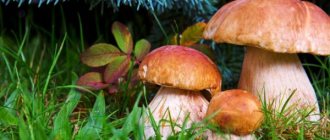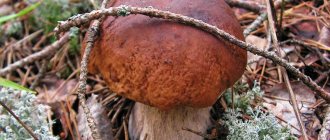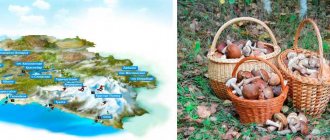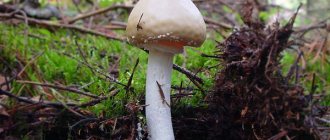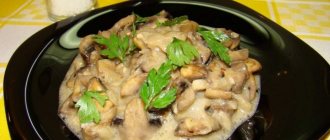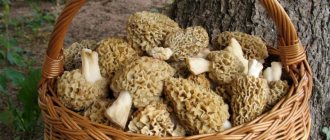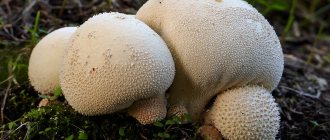Both novice mushroom pickers and experienced lovers of quiet hunting will be interested in information on how to pickle mushrooms, what types are suitable for this kind of preparation, and how to properly prepare them for pickling. A simple and affordable way to process the collected mushroom abundance will allow you to supplement your menu with an excellent snack.
Mushrooms of Primorsky Krai - overview, features and description
How experienced housewives prepare mushrooms: canned, pickled, dried, frozen, pickled and much more. In our region, mushroom hunting begins in mid-summer (some varieties), but the main concentration of mushroom pickers in the forests is in early autumn. Today we have to explore the range of forest mushrooms of the Primorsky Territory: which varieties grow, which are edible and poisonous. Or maybe mushroom hunting in this region can surprise us with something? First things first.
Types of forest mushrooms: edible
All mushrooms are divided into 3 groups: edible, inedible and poisonous.
Those specimens that do not pose a danger to human health if eaten without heat treatment are considered edible; in simple words, they can be eaten raw. But you should not neglect safety measures, as cases of mild poisoning from edible mushrooms have also been recorded. Their distinctive property from other representatives of the plant world is that they are able to “draw into themselves” all the microelements and the general chemical composition of the soil on which they grow. Therefore, you eat not just a mushroom, but also what it grew on. Be sure to boil them, and then at your discretion.
They can be distinguished by their external characteristics: under the cap there are holes or plates that resemble a sponge. Otherwise they are called “tubular” or “lamellar”.
In the Primorsky Territory, mushrooms that can be classified as edible are: porcini mushroom, oyster mushroom (common, palm, elm and autumn), white mushroom, boletinus, valui, volnushka, St. George's mushroom, gladysh, mushroom noodles and many others.
How to prepare mushrooms for pickling?
Preparing mushrooms for pickling is an important stage, and the final result will depend on the quality of its execution. The technology for processing the base product entirely depends on the type and variety of mushroom specimens.
- Lacteal mushrooms: milk mushrooms, milk mushrooms, serushki require preliminary long-term soaking to get rid of their inherent bitterness contained in the milky juice. To do this, the prepared mushroom mass, cleared of contaminants and pre-washed, is kept in salted water for at least three days. The water is changed as often as possible, but at least three times a day.
- Lamellar mushrooms are not sorted by size, but the stems must be removed.
- Tubular mushrooms are chosen to be medium-sized or cut into several parts for better salting.
- Often, mushrooms are boiled until cooked or half cooked, adding a little salt to the water to taste.
Types of forest mushrooms: inedible
Inedible mushrooms include those representatives of the plant world that have an unpleasant odor and taste. They can be bitter and cause minor digestive problems. Some people also include poisonous mushrooms in this category. But this is an incorrect definition, since they do not contain toxic enzymes. The inedible mushrooms of the Primorsky Territory are the following representatives: beautiful-legged bolete, lady with a veil, coral mushroom (spruce hornet, blunt, beautiful), red mustache, pepper butterfly and others.
Poisonous types of mushrooms
Poisonous mushrooms are those that contain toxins. They, in turn, are also divided into 3 groups according to the risk of danger:
- Promoting digestive poisoning.
- Causing damage to the nervous system.
- Deadly poisonous.
In the Primorsky Territory, poisonous mushrooms are: pale toadstool, boletus purpurea, all types of fiber, gymnopilus, talker (whitish, bleached), gall mushroom, false valui and many others.
Medicinal mushrooms of Primorsky Krai
Edible mushrooms are not only delicious in their taste, but can also be very beneficial for our health. For example, in Primorye there are medicinal mushrooms that will help improve your health in case of illness. These include: porcini mushroom, ilmak (lemon oyster mushroom) and mushroom noodles (hericium or combed urchin). Read more about each of them below.
The porcini mushroom grows in many regions of our country, including Primorye. It belongs to category 1 edible mushrooms. This means that it is tasty, satisfying and nutritious - a real mushroom excellence. Its pulp contains large quantities of vitamins (A, E, D), microelements (Se, K and others). Phytohormones, polysaccharides and essential amino acids take part in important life processes of the body.
Experts, in the course of various analyzes and studies, came to the conclusion that the porcini mushroom increases antibiotic and antitumor activity. Based on this, pharmaceutical drugs were created to combat these diseases. Due to the presence of potassium and alkaloid in large dosages, the mushroom takes part in the treatment of atherosclerosis and the cardiovascular system.
Ilmak (or lemon oyster mushroom), like porcini mushroom, also has antitumor and antioxidant activity. But among other things, lovastanin contained in ilmak can lower blood sugar levels and prevent the development of cholesterol. Immunostimulating properties help fight viruses in the cardiovascular system. But this is not the entire spectrum of action of oyster mushroom: it does an excellent job of removing oxidation products from the kidneys and liver. The radioprotective properties of this medicinal mushroom in the Primorsky Territory (and not only) were used as infusions by the liquidators of the Chernobyl nuclear power plant.
Mushroom noodles have antiseptic and immunostimulating properties. Mushroom infusion treats stomach diseases in folk medicine and stimulates digestion processes. It is able to restore disorders in the nervous system and inhibits the biological processes of aging. In the east, this mushroom is called the “elixir of youth.”
These are the unique mushrooms that grow in the Primorsky Territory.
How to pickle mushrooms for the winter?
Any pickling of mushrooms for the winter has both its own individual characteristics and general points that can be applied to any other recipe.
- Mushrooms must be sorted, getting rid of wormy or spoiled fruits.
- Selected specimens are cleaned using a brush, sponge or knife, and if there is heavy dirt or sand, they are thoroughly washed under running water.
- When used as a base component for salting milkweeds, they are soaked in salted water for at least three days.
- Mushrooms are salted raw or boiled for 15-20 minutes.
- While studying methods of pickling mushrooms, they choose the best option for themselves, which they can adapt to their preferences, adding other flavorings, seasonings, spices, herbs, and herbs.
Quick pickling of mushrooms
This recipe will help you figure out how to pickle mushrooms, so that after a couple of days you can take the first sample and enjoy the excellent taste of the resulting snack. Preliminary boiling of the prepared mushroom mass will speed up the preparation of the delicacy until the fruiting bodies are ready or sink to the bottom.
- mushrooms - as many as available;
- salt - to taste;
- currant leaves, horseradish, dill umbrellas, garlic, bay, pepper.
- Prepared mushrooms are boiled in water salted to taste until they sink to the bottom.
- Drain the mushroom mass in a colander, place it in a saucepan, alternating with herbs and chopped garlic and adding salt to the layers to taste.
- Press the contents of the container with a weight.
- Pickling mushrooms lasts 3 days at room conditions, after which the appetizer is put into the cold for storage.
Cold pickling of mushrooms for the winter - recipe
To preserve the maximum amount of valuable vitamins, cold pickling of mushrooms is preferable. In this version, the appetizer can be tried no earlier than a month and a half later, but the long wait is compensated by the excellent taste of the resulting dish. Ryzhiki can be salted without adding dill and garlic - their natural taste is incomparable in itself.
- mushrooms – 2 kg;
- salt – 2/3 cup;
- garlic – 3-4 cloves;
- dill - 1 bunch.
- The mushrooms are prepared properly and placed in a container suitable for pickling, caps down.
- The layers are sprinkled with salt, topped with dill and chopped garlic.
- Press the mushroom mass with a weight, leave until the juice separates for 1-3 days at room conditions, after which it is put into the cold for at least a month.
Hot pickling of mushrooms in jars
Read more about how to properly pickle mushrooms using a hot method. This option is for those who are afraid to prepare the product without preliminary heat treatment. After cooking in brine, the mushroom mass can be transferred to jars, which, after the contents have cooled, are taken to a cool cellar or put in the refrigerator.
- mushrooms – 2 kg;
- water – 1 glass;
- salt – 4 tbsp. spoons;
- laurel – 2 pcs.;
- cloves and black pepper – 6 pcs.;
- currant leaves – 4 pcs.;
- dill seeds – 1 teaspoon.
- Prepared mushrooms are boiled for 20 minutes in water with salt, adding pepper, cloves, bay and dill.
- Further hot pickling of mushrooms will continue in jars into which the mushroom mass with brine is transferred.
- After the containers have cooled, they are put into the cold for a month and a half.
Salted mushrooms under pressure
With classical methods of harvesting and not only using pressure for pickling mushrooms, which can be a bottle filled with water, or a heavy clean stone, which is placed on top of a plate covering the surface of the contents of the container. Special wooden barrels or enamel vessels are used as vessels for pickles.
- mushrooms – 2 kg;
- salt – 100 g;
- laurel – 2 pcs.;
- dill and currant leaves - to taste.
- The prepared mushrooms are placed in a suitable container in layers, sprinkling each with salt.
- Greens are placed at the bottom of the vessel and on top of the mushrooms.
- Cover the contents of the container with clean gauze or a piece of fabric, and determine the pressure on top.
- Leave the mushroom mass for salting for 1.5 months in the cold, changing the gauze to clean one every 3 days.
How to pickle mushrooms in a barrel for the winter?
The following recommendations will help you acquire knowledge of how to pickle mushrooms in wooden barrels. Oak containers are pre-soaked to swell and prevent leakage, and then rinsed with boiling water and soda. For additional sterility, the inner surface of the barrels is fumigated with juniper.
- mushrooms;
- salt – 30-40 g per 1 kg of mushrooms;
- greens, bay, pepper, garlic, leaves and horseradish root (optional) - to taste.
- A layer of salt is poured into a prepared oak barrel, herbs and spices are added as desired.
- Next, lay the mushrooms with their caps down, sprinkling the layers with coarse rock salt.
- Place the load on top.
- Salted mushrooms in a barrel will be ready for consumption in 30-45 days.
Useful properties of mushrooms
In addition to the beneficial properties of individual mushrooms described above, there are common characteristics that are common to all edible mushrooms. They contain many useful substances: proteins, fats, carbohydrates, minerals, vitamins A, B, C, D, PP. The amount of proteins and fats is small, but they contain many essential amino acids.
Mushrooms can be classified as a low-calorie product. Since 100 grams contain only 30-35 kilocalories. But the nutritional properties and taste are great, which makes it even more attractive for any person’s diet. And the large assortment of edible mushrooms in the Primorsky Territory will allow any mushroom picker to experience gastronomic pleasure.
The most popular recipes for pickling mushrooms
Probably, every family has its own traditions of preparations - “grandmother’s” secrets, passed on to subsequent generations.
The most common and accessible methods are cold salting methods, which allow you to preserve as much as possible the beneficial properties of the valuable mushroom product. The technologies are simple, but the cooking process is quite lengthy and is based on natural fermentation. The mushrooms are actually cooked in their own juice, gradually salting and acquiring a piquant sourness, while their flesh remains dense and elastic.
A simple recipe for cold pickling in your own juice
Any mushrooms can be prepared using the cold method, but the correct ones for such pickling are saffron milk caps, milk mushrooms, trumpet mushrooms, russula, and champignons. Ready-made pickles turn out to be very tasty; they are served as an independent snack, seasoned with chopped onions and seasoned with vegetable oil, or added to various meat and vegetable dishes.
Number of servings/volume: 3 l
Ingredients:
- fresh mushrooms – 5 kg;
- rock salt – 200-250 g.
technology :
- Mushrooms are cleaned of debris and impurities, and if necessary, washed under running water immediately or after a short soaking (no more than 20-30 minutes). Pure mushrooms are sorted by size, large ones are cut into pieces. Some housewives additionally recommend quickly pouring boiling water over them or blanching them in boiling salted water (1 teaspoon per 1 liter) for 3-5 minutes. Before pickling conditionally edible mushrooms, for example, milk mushrooms, russula or volushek, they must be soaked in cold water from 5-6 hours to 2-4 days, changing the water twice a day.
- Pour a handful of salt into the pickling container and distribute it over the entire bottom. Prepared mushrooms are laid in layers, sprinkled evenly with salt. For saffron milk caps, take 40 g of salt per 1 kg, for all others - 50 g.
- If desired, spices are added between the layers of mushrooms: pepper (black peas and allspice), bay leaf, dill, chopped onion, garlic cloves, dry cloves, horseradish, cherry or blackcurrant leaves. Spices impart different flavors, so their choice and quantity depend on personal preferences.
- After salting, the container is covered with a wooden circle or a flat plate, on which a load is placed. Once the mushrooms have settled, you can add new ones until the container is full.
- Place the container with mushrooms in a cool, dry place, away from sunlight. After 5-6 days the condition of the workpiece is checked. If there is too much brine, you can pour it out, put it in the refrigerator, and then add it back if necessary or use it to make sauces. When there is not enough brine, it is recommended to increase the load or add a small amount of boiled water.
Where to look for mushroom places in Primorye?
At the beginning of August, a “hot” period begins for seaside mushroom pickers. Porcini mushrooms, milk mushrooms, white mushrooms, boletus mushrooms, boletus mushrooms, russula, boletus mushrooms, honey mushrooms, saffron milk caps and others fill the baskets of mushroom seekers. The most favorite among them is the porcini mushroom. We will now find out where to collect porcini mushrooms in the Primorsky Territory.
Despite the fact that mushroom pickers do not like to share the secrets of the rich habitats of their prey. However, there are places in Primorye where you can always find more than one mound of the desired “hats”. If you are just a beginner mushroom picker, we recommend that you visit such mushroom places as Putyatin Island (in Peter the Great Bay), the village of Blagodatnoye (in the Khorolsky district) and the village of Tavrichanka (in the Nadezhdinsky district).
How to find a mushroom place
Having visited the taiga a couple of more times, you will learn to navigate it and easily study mushroom geography. In general, in Primorye, almost all forests are mushroom. Mushrooms are found both in urban areas - parks and squares, and on islands located a considerable distance away from the mainland. Mushroom areas are not homogeneous - they contain places rich in mushrooms and forest areas unfavorable for the growth of mushrooms.
Outside the forest, among the known edible mushrooms, valui, umbrellas, champignons and puffballs can grow, settling in clearings and forest edges. Since each type of mycelium prefers areas with a certain soil composition and a set of vegetation (primarily trees), mushrooms can grow anywhere. The most famous places for collecting almost all well-known mushrooms are cedar forests, birch groves, birch plantations, birch forests with an admixture of coniferous trees, pine forests and mixed forests.
Let's try to list the places where mushroom growth is impossible or unlikely. Here are places where known edible mushrooms are unlikely to appear:
- dense forest thickets and windbreaks;
- dark and heavily marshy areas;
- extensive plantations of lingonberries and blueberries (exception: chanterelles and chickens can grow (as the ringed cap is called in Belarus);
- vast open forest glades, well lit by the sun;
- areas with tall and dense grass (except for spruce mushrooms);
- alders, willows and junipers.
The main seasonal regulator of mushroom areas is the weather. Here are some general observations. In cold weather, mushrooms prefer hills that are located away from trees, and in hot weather, places near tree trunks. During dry summers and autumns, they grow best in areas moistened by springs, streams and rivers, as well as along the edges of swamps. In the forest they find refuge on the shady northern slopes. During the very rainy season, it is best to look for them on hills, mounds, mounds, along forest paths and roads, along the edges of the forest.
So, it is not recommended to collect any mushrooms:
- in parks and squares;
- within the city limits;
- in industrial areas and nearby;
- in forest plantations and the nearest forest zone along highways;
- along railway lines;
If you decide to purchase mushrooms, remember that mushrooms sold on the market “from hand” can be collected in contaminated or contaminated places. An exception may be chanterelles.
Interesting read: .
How to choose edible fresh mushroom?
When you collect porcini mushrooms in the Primorsky Territory or any other edible ones, you must follow the following rules:
- The mushroom must be clean (in the area of the plates or tubes on the inside of the cap).
- The color of the spores on the cap should match their natural color.
- The hat must be securely fastened.
- The protective film (Volva) must be present on the cap and must not be damaged.
- When cutting a mushroom, pay attention to the rings. The color should be natural and without damage.
- If you doubt which mushroom is in front of you, leave it.
These rules will allow you to avoid unpleasant consequences after a mushroom catch.
A unique mushroom of the Primorsky region
In the mushroom kingdom there is a special place for one mushroom, which is called the “royal”. This is how the mushroom grows in the Primorsky Territory, and it is also called “Caesar’s mushroom,” “Caesarean mushroom,” “Caesarean fly agaric,” and “Caesar’s fly agaric.” Despite the combination with the word “fly agaric”, it is not only edible, but even a delicacy.
In appearance it is very similar to the fly agaric, a deadly mushroom. Therefore, in order not to confuse the royal mushroom with the fly agaric, we will give an example of their obvious differences:
- The cap of the Caesar mushroom is smooth, without bulges. And the fly agaric has white “warts” on its cap.
- The plates under the cap of the royal mushroom are golden yellow. The fly agaric has white ones.
- The protective film of the royal representative is wide, more like a bag, loose. The fly agaric sits firmly and looks like ring-shaped remains at the base of the leg.
The royal mushroom prefers dry and warm places. It can be found not only in Primorye, but also in Georgia, Azerbaijan, Crimea, the North Caucasus and Transcarpathia.
The nutritional value of this mushroom is that its cap is fleshy, the stem is completely white - without taste or smell. They are fried and baked over an open fire, dried and even used raw in some salads (if the protective film is intact).
Time and place of mushroom growth in Primorsky Krai
In the Primorsky Territory, especially in the south, edible mushrooms grow from the first half of May to the end of October, that is, for almost 6 months. The time of appearance and quantity of edible mushrooms varies in individual years. The greatest harvests of edible mushrooms occur in years with a dry beginning of the growing season, when then in August - September there is enough moisture. More than once, large harvests of mushrooms have been observed during flood years. For mushrooms to appear, sufficient moisture is required not only in the soil, but also in the air. The development of fruiting bodies does not occur even after heavy rain, when it is followed by hot, dry sunny days.
Different types of mushrooms grow at different times: ilmaki from May to September, some mushrooms finish growing in early June (May mushroom), and such as golden scale appear in large quantities at the end of May - June, then the formation of fruiting bodies stops until autumn, when they appear again in significant numbers; Late yellow mushrooms (alders) grow from the second half of September and throughout October. The largest number of edible mushrooms in the southern part of Primorye appears in August and September. In the north, mushroom growth lasts a little more than two months. The mushroom season ends in August.
Interesting read: .
On the mountains in the upper forest belt, the mushroom season is much shorter than at the same latitude, but in the lower vegetation belt. In the southern part of Primorye there are many edible mushrooms that are absent or very rare in other regions of Russia. These include: painted beletinus, larch mothball, fir butterfly, Far Eastern obabok, colored-legged obabok, black-brown obabok, blushing flyweed, Sakhalin champignon, Udemanciella brown-edged, elmaki, alder mushroom, Far Eastern caesarean mushroom, May mushroom, flat-capped champignon , willow, or golden scale, fir milk mushroom, Brezadola milkweed, Ussuri stitch, coral mushrooms - beautiful cluster-like, mushroom noodles, lobed blackberry, motley chanterelle, tree abalone, hairy and black.
Among the listed species there are many popular ones with good taste; most of them, as can be seen from the table, are associated with species such as oak, elm, maple, fir, which are not found in the north. In lean years, when there is little rainfall during the mushroom season, mushrooms growing on wood are the least sensitive to unfavorable conditions. But there are species for which dryness even favors the development of fruiting bodies - these are garlic mushroom and false chanterelle.
General description of mushrooms
Almost all known mushrooms in the Primorsky Territory grow in other areas. There are 800 species in total, of which only about 300 are edible. Large harvests of porcini mushrooms are harvested here every 3 years.
All mushrooms of the Primorsky Territory are divided according to the degree of edibility into:
The first 2 groups are divided into their own taste categories. The 1st category includes the “kings of the forest” - porcini mushrooms and all their varieties. They are loved for their special strong aroma (especially when dried) and exquisite taste. They are served as an appetizer, as a main course, or in soups. They are even suitable for a raw food diet.
This same taste category includes milk mushrooms and saffron milk caps, champignons and volushki, oak mushrooms and poddubki.
Representatives of the 2nd category, which include boletus, boletus, aspen and boletus, are considered slightly worse in taste and less aromatic.
The 3rd category includes honey mushrooms, moss mushrooms, morels, volushki, etc. They are served as pates, enhancing the taste and aroma by adding spices.
Specific mushrooms of the 4th category are also low-aromatic. They are conditionally edible and require long-term, thorough pre-processing - soaking and cooking. These include oyster mushrooms, hedgehog mushrooms, spiderworts, dung beetles, etc. If such specimens are prepared incorrectly, poisoning occurs.
Before you go harvesting, it is better to find out where the mushroom places are located in Primorye, which representatives of forest mushrooms you should not touch with your hands, how edible ones differ from inedible ones, and how to properly handle the mycelium so as not to damage it.
Edible
The list of edible mushrooms in the Primorsky Territory is long. The most popular names:
- garlic mushroom;
- false chanterelle;
- white slimy honey fungus;
- whitefish;
- autumn oyster mushroom;
- wave;
- real milk mushroom;
- winter honey fungus;
- autumn honey fungus;
- real fox;
- May mushroom;
- oiler;
- real flywheel;
- green flywheel;
- flickering dung beetle;
- boletes (boletus, boletus);
- loader;
- gray row;
- side;
- morel;
- Sakhalin champignon;
- creaky.
They appear at different times of the year, each of them has its own fans who prefer this particular species for collecting.
Irina Selyutina (Biologist):
Mushroom pickers in the Primorsky Territory have their own signs (as in any other region of Russia) that allow them to collect good harvests:
- Porcini mushrooms usually bear fruit abundantly after two years on the third, but unfavorable weather conditions can “knock down” this system.
- The oak, birch and cedar forests located on the southern slopes of the hills are considered the most mushroom-bearing;
- for the northern regions, the main places for collecting mushrooms are mixed forests, birch forests and cedar trees;
- in the western part of the region, pine forests are considered “respected” mushroom places;
- When there is little rainfall during the mushroom season, mushrooms growing on wood are least affected.
Did you know? The edible Russula Vasilyeva is considered endemic to Primorye, which differs radically from its counterparts in the clearly visible remains of a private cover: on the surface of the cap in the form of large shreds and in the form of a ring on the stem.
Poisonous
Poisonous mushrooms cause severe poisoning
In the Primorsky Territory, poisoning with poisonous mushrooms occurs every year. Not only because they are collected near roads or residential areas. Edible ones are often confused with their inedible, or poisonous, counterparts. To avoid tragic mistakes, you need to know the poisonous mushrooms of Primorye, what they look like, what they are called and what is their difference. There are more than 20 species of poisonous and inedible mushrooms in the Primorsky Territory.
Common names:
- pale grebe;
- pepper mushroom, or pepper buttercup;
- boletus purpurea;
- whitish talker;
- gall fungus;
- false scent;
- red fly agaric;
- shaggy dung beetle;
- satanic mushroom;
- striped row.
Some of them cannot be handled. The toadstool is capable of transmitting toxins through the skin, after which the same poisoning of the body will occur as after eating it. It is often confused with honey mushroom. The difference is in the “skirt” located on a thin leg. As it develops, the cap of the toadstool flattens. At the base, the leg has a tuberous, clearly visible and reminiscent in appearance extension, covered with a volva - the remains of a common blanket, forming a “bag”, half immersed in the soil.
Preparing mushrooms for pickling
Salting is a universal harvesting method, suitable for all edible and conditionally edible varieties. The pickling technologies used are almost the same, but the preparatory stage has its own nuances: edible mushrooms are salted for the winter without any preliminary treatments (often without adding seasonings), and conditionally edible mushrooms must first be soaked or boiled, changing the water several times to remove bitterness and acrid taste.
The harvested crop should not be left unattended for longer than 3-4 hours. Mushrooms must be used immediately for cooking or processing. First of all, they should be sorted by type and cleaned. Many mushroom pickers recommend limiting themselves to dry cleaning, scraping or cutting off dirt from the stems and removing debris stuck to the caps with a soft brush or sponge. This is especially true for varieties intended for drying. If there is a large amount of sand, the mushrooms have to be soaked briefly in cold water, and then washed and boiled in brine.
For boiling, the brine is prepared at the rate of 1 tbsp. l. salt per 1 liter of water. Mushrooms are immersed in boiling water for 10-15 minutes. During cooking, sand settles to the bottom of the pan, and plant debris (needles, grass, leaves) rises to the surface along with the foam. Therefore, the mushrooms are not mixed intensively, but only submerged with a spoon, skimming off the foam. Then they are carefully placed in a colander with a slotted spoon, never falling out of the pan, and washed with running water.
Application
Primorye mushrooms are most widely used in cooking. They are used to make soups and prepare hot dishes. They are fried, boiled, pickled, salted, dried and frozen.
There are a lot of russula in the forests of Primorye. Russula Kale with a bright purple cap, which has never been heard of in the Moscow region, is good for pickling and housewives are happy to stock it up for the winter.
Honey mushrooms and boletus mushrooms are collected en masse throughout the season.
The Far Eastern obabok is suitable for any use. Its flesh is elastic and dense, pleasant to the taste. The fruiting body reaches large sizes (up to 25 cm in cap diameter). The fungus is found in oak groves in late summer and September.
Description
Lat. Pleurotus citrinopileatus - Golden pleurotus. Other names: Lemon oyster mushroom, yellow oyster mushroom, golden oyster mushroom, elmak, golden pleurotus, elmovik.
Fruiting bodies are located on trees without any particular pattern, up to 30 pieces in the form of compact clumps. Alone they are very rare. Oyster mushrooms grow on dry trunks and stumps of the Far Eastern elm. Hence the name - ilmovik.
hat
A mature oyster mushroom has an almost white cap, irregular funnel-shaped with a lobed edge. In a young mushroom it is lemon-yellow in color, flat, with a depression in the middle. The diameter can vary from 5 to 30 cm. The plates are white or white-pink, can run down to the stem, are located evenly and relatively tightly.
Pulp
The pulp is soft and fleshy. The younger the mushroom, the juicier it is. When moving from the cap to the stem, the flesh becomes coarser. It is white in color and smells like flour.
Leg
The leg can reach eight centimeters in length and three in width. It is often located eccentrically, cream-colored. Some ilmaks have a weak leg, while others have no leg at all. This is explained by the adaptation of the fungus to environmental conditions.
We now know what oyster mushroom looks like. Where can a mushroom picker look for it?
Edible mushrooms of the Primorsky region
Many people love to spend their time walking through the forest. This significantly improves health and brings a lot of pleasure, because it is there that you can find many delicacies for home preservation. Mushrooms of the Primorsky Territory (edible) are no exception in this case. Their taste cannot be compared with anything.
But you need to know exactly what products can be collected and used for food, and why it is better to refuse.
Types of mushrooms
The Primorsky region is distinguished by a wide variety of mushrooms. A bountiful harvest of this delicacy can be collected from March to November in city squares and parks, groves and forests. There are approximately 800 species of mushrooms growing in this area. Of these, about 350 can be eaten. There are varieties that grow only in coastal climates. It is for this reason that they are considered rare. It is worth immediately noting that edible varieties do not need to be subjected to heat treatment at all before eating them. Thanks to them, the body is saturated with essential microelements and vitamins.
But inedible mushrooms contain a large number of poisons. This can cause poisoning and subsequent death.
Edible mushrooms, depending on their taste, are divided into the following types:
- Conditionally edible. These include dung beetles and cobwebs, as well as oyster mushrooms. They are allowed to be eaten only after soaking them in a saline solution for a long period. Otherwise, food poisoning may occur.
- Used in the culinary field for the preparation of a variety of seasonings and dressings: volnushki and flywheels, honey mushrooms and linden.
- There are also less elite mushrooms of the Primorsky region, which have an average taste: boletus and boletus, rows. They are consumed in dried and canned form, since it is from them that canning is prepared at home.
- Delicacy varieties include oak and saffron milk caps, white and champignons, as well as milk mushrooms. These mushrooms have a pronounced aroma and unique taste characteristics. It is from these varieties that you can prepare snacks, first and second courses.
What mushrooms are salted?
Having collected baskets full of fragrant gifts from the forest in the forest, and starting to process them, it is important to understand which mushrooms are salted for the winter, and which ones are better to discard and use them in everyday culinary dishes.
- All lamellar mushrooms are ideal for pickling: milk mushrooms, milk mushrooms, saffron milk caps, chanterelles, serushki, russula, autumn mushrooms and champignons.
- From the tubular ones, porcini mushrooms, boletus mushrooms, boletus mushrooms, boletus mushrooms and boletus mushrooms are pickled.
- The leader in the taste characteristics that mushrooms acquire after salting and in the valuable properties they contain are milk mushrooms. Although this type requires lengthy preliminary preparation and soaking, it is ideal for pickling.
Edible varieties
The most common edible mushrooms in Primorye are russula and row mushrooms, porcini mushrooms and boletus mushrooms. Their taste and aroma are different from others.
Edible mushrooms have the following characteristics:
- White is considered a delicacy due to its unique taste and appearance. Its distinctive feature is its contrasting colors. Its cap is a rich brown color, but its leg is white and can reach a diameter of 20 centimeters.
- The boletus is also called the redhead because of its brown-red cap. It can reach 10 - 30 centimeters. But its leg can have a size of 18 - 22. The species is considered rare, since it grows well in moist soil. Fruiting occurs until the outside temperature drops below 0 degrees. Redhead can easily be confused with bitterling, a poisonous variety.
- The rows look like russula. When collecting, you should pay special attention to the appearance of the product and the conditions of its germination, since there are both edible and poisonous varieties of the crop. A distinctive feature is germination in rows. Ryadovka can be found in mixed forests of Primorye. They are collected in the last days of September. Before eating, mushrooms must be heat treated.
- Russulas grow abundantly in the Primorsky Territory. Their height can reach 12 centimeters. There are many varieties of them. The most famous types are: pink, yellow and greenish. They can be used for winter preservation. They grow well in any soil. Collection can begin in July. Quite easily they can be confused with a toadstool.
- Volnushki are also excellent for winter harvesting. They have a small pink fringed cap. This mushroom does not grow more than 8 centimeters. Fruiting occurs in the last months of autumn. This variety does not have a poisonous counterpart.
How to store salted mushrooms?
It is important not only to properly prepare the snack, but also to store salted mushrooms at home in accordance with all requirements.
- Salted mushrooms are often stored in the same container in which the salting process took place. In some cases, the workpiece is transferred to jars, making sure that the fruits are completely covered with brine.
- For better preservation, a layer of calcined and cooled vegetable oil is often poured into the container with the workpiece.
- For long-term storage, the snack is placed in a cool room with a constant temperature of +1 to +5 degrees. This could be a refrigerator or a cool cellar.
- You cannot store mushrooms, or pickle them, in metal or clay containers. Ideal containers are wooden barrels, tubs, enamel or glass containers. When choosing enamel dishes, check the integrity of the enamel and at the slightest hint of chips, look for another vessel.
How is hot pickling of mushrooms done? This topic is always of interest to good housewives. Mushrooms are a delicious delicacy that almost everyone loves. Fortunately, nature generously shares its riches with us. There are a large number of recipes for their preparation. They make excellent julienne, solyanka, and soups. But how nice it is in winter to open a jar of salted mushrooms and eat them with potatoes! For this, hot pickling of mushrooms for the winter will come in handy.
Harvesting mushrooms will allow you to enjoy their taste and aroma even in winter.
The largest harvest is usually harvested in September, but it is not possible to keep mushrooms fresh for a long time. Therefore, there are several options here. They can be dried or frozen. But there is another way to preserve the harvest - hot pickling. So, how to prepare delicious preserves. First you need to figure out what mushrooms can be used for this purpose.
Poisonous types
Almost every day at least one person becomes a victim of inedible mushroom poisoning.
And all because of carelessness during collection and improper preparation.
More than 20 varieties can be considered hazardous to health.
At the same time, it is forbidden to even pick up some of them, since poisonous substances can penetrate the skin into the body.
The following varieties are considered inedible:
- The pale grebe has a white leg framed with rings. The mushroom can reach 9 centimeters in diameter. His danger level is high. Accidental consumption of even a small piece can result in fatal poisoning.
- The red fly agaric has an original appearance. The height of the cream leg can reach 15 centimeters. The hat is red-orange in color with white dots on it. Mid-summer is the period of active growth. It cannot be confused with other mushrooms due to its appearance.
- Because of the brown-brown cap, the beautiful-legged boletus resembles a boletus. It has a squat appearance due to the cylindrical leg, the bottom of which is red and the top is dark beige. The inside of the hat is covered with yellow plates. This variety germinates under various conditions.
- A mushroom called the lady with the veil poses a danger to human health. Her hat is olive-colored and covered with a sticky coating. You might think that the mushroom is shrouded in a cobweb veil.
Why is soaking necessary?
Before salting, mushrooms are thoroughly washed with running water.
Mushrooms such as milk mushrooms and valui secrete milky juice after being cut. If you do not soak them, the preservation will turn out bitter. Saffron milk caps and russulas are not soaked, as they do not emit such a substance.
Milk mushrooms and volushki are soaked for 1 to 1.5 days;
If you have black milk mushrooms or valui, then you need to keep them for about 5 days. Please note that each type of mushroom may require a certain amount of time. In addition, the region where they were collected must also be taken into account.
At the same time, during the soaking process, you need to regularly change and salt the water. Salt is added to prevent mushrooms from spoiling in water. However, this does not mean that you do not need to change the water! Soaked mushrooms need to be peeled again.
Return to contents
Harvest period
Before you start planning a mushroom harvest, it is necessary to take into account the regional characteristics of the area where the forest delicacy grows. Some varieties can ripen from early spring until the onset of frost. The best period for harvesting is considered to be August and September.
It is also worth noting that the active growth of a forest delicacy can take 6 months, and in the southern region - 8. In the northern side of the region, this time is significantly reduced due to the cold climate.
Fans of “quiet hunting” are well aware of the mushroom places in the Primorsky Territory: mixed and deciduous, as well as coniferous forests. In addition, mushrooms can be found in birch and cedar groves.
The mushroom picker's calendar looks something like this:
- June is the month for collecting milk mushrooms and boletus, as well as boletus. They grow en masse and bear fruit until the end of autumn.
- July is the season for collecting porcini mushrooms. This month you can start looking for chanterelles and milk mushrooms, as well as russula, which taste quite pleasant. They have gained great popularity in the culinary arts.
- In August, in Primorye you can find saffron milk caps and boletus, as well as common mushrooms and boletus. It is in this month that conservation for the winter begins.
- From September you can start collecting autumn varieties.
- In October, the “silent hunting” season comes to an end, as the first frosts arrive.
If the weather conditions are unsuitable, the Primorsky Territory will cease to please mushroom pickers with its harvest. In very rainy weather, you need to look for mushrooms on the edges and paths, and in drought - near water bodies.
You also need to remember that the product does not grow in swampy areas and impenetrable forests . You should not harvest near railways and industrial facilities, as well as near highways.
It is also not recommended to do this in city parks and squares.
Such fruits are poisonous, as they are filled with a large amount of toxic substances. Even if the mushroom is of the edible type, it can still cause food poisoning, which can be fatal.
When entering the forest, it is worth dividing the area into several sectors and going through them one by one. Many mushroom varieties like to hide in the grass. Species such as boletus and boletus, as well as boletus and boletus, can be found in the ditch.
For a walk in the forest, you need to choose the right clothes. You will also need containers for harvesting. Water is a must when going into the forest.
Pickling recipes for storage
Now we proceed to the actual pickling of mushrooms. There are several options. You can pickle hot, cold or dry. Here is a hot salting method.
Tubular and lamellar mushrooms are suitable for this type of pickling. Take 50 g of salt per 1 liter of water and boil the mushrooms. We count the cooking time from the moment the water boils:
- Boil porcini, boletus and other tubular mushrooms for at least 10-15 minutes.
- If you have milk mushrooms, then from 7 to 10 minutes.
- It will take at least 10-15 minutes to cook russula and milk mushrooms.
- You need to cook the champignons for about 15 minutes.
- Honey mushrooms take the longest to cook: at least half an hour.
- You can simply pour boiling water over the saffron milk caps several times.
Mushrooms must be thoroughly boiled.
It’s easy to check the readiness of mushrooms. The broth should become transparent, and the mushrooms themselves should settle to the bottom of the pan. If you did everything correctly, they will be strong. Recipes recommend waiting a while for the mushrooms to settle, and then start pickling.
The cooled mushrooms need to be transferred to a bowl and sprinkled with salt (approximately 2-3% of the amount of the harvest). Then you need to add spices and seasonings to your taste. Pour in the prepared brine (the broth in which they were cooked). Then add dill seeds and a few cloves of garlic. Then you need to add sunflower oil with a thickness of 1 cm.
The time it takes to pickle mushrooms using this method is about a month. After which they can be consumed. Preservation is stored in the cellar or in the refrigerator. The optimal temperature is from 0°C to +4°C.
Safety precautions
When eating mushrooms, even an experienced mushroom picker should be especially careful. During the process, you should adhere to the following rules:
- There is no need to collect unknown mushrooms. It is recommended to choose only those types that have been tested over the years. It’s better not to listen to the advice of friends.
- You should pay special attention to the location and appearance of the product. Mushrooms absorb all toxins and harmful substances. If there is a dirty river, road or landfill nearby, the product will be toxic.
- The cut location must be examined carefully. If the mushroom is inedible, the color of the stem will change immediately after it is separated from the root system.
- Processing of the product needs to begin faster. It needs to be sorted through carefully and cleaned of excess. Spoiled and wormy specimens should be removed from the general mass.
- The harvested crop needs to be soaked for some period in a saline solution. Thanks to such manipulation, all the pests that live inside will come out of the mushrooms. Before starting canning or frying, the product is boiled. It is allowed to eat only white varieties of mushrooms without heat treatment, provided that they were collected correctly.
- People with kidney failure and gastrointestinal problems should eat the product with extreme caution. Digesting mushrooms is quite difficult. It is also prohibited to give forest gifts to young children.
Primorsky region is rich in mushrooms. It grows a large number of rare and edible varieties. But you should be careful during the collection process.
Otherwise, they can be confused with inedible varieties and get food poisoning. In this case, you should seek medical help as soon as possible.
Sources:
https://www.syl.ru/article/345244/gribyi-primorskogo-kraya—obzor-osobennosti-i-opisanie https://fermoved.ru/gribyi/primorya.html https://domsad.guru/griby/ sedobnye-griby-primorskogo-kraya.html
